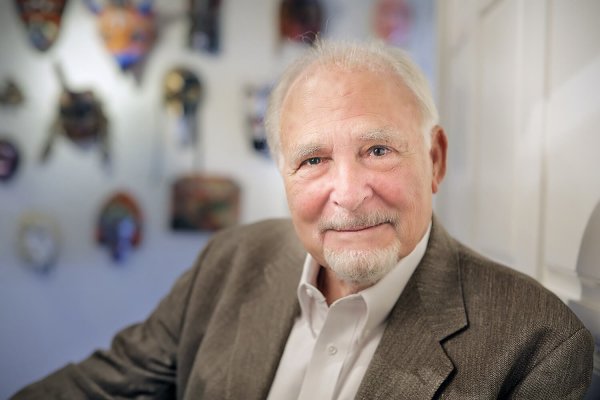Microexpressions According to Paul Ekman


Written and verified by the psychologist Gema Sánchez Cuevas
Paul Ekman is considered by the American Psychological Association (APA) to be one of the most prestigious and influential psychologists of the 21st century. He is a leader in the areas of lie detection and the relationship between emotions and facial expressions. On top of all of that, he co-discovered microexpressions. In this article we’ll explain what they are, what they look like, and why they’re important!
Ekman says that we give microexpressions during conversation. These can and usually do go completely unnoticed by the potential recipient. They’re very brief facial movements, uncontrolled by the person. They represent different emotions, which we will discuss below.
From facts to the theory
Paul Ekman is one of few who best knows how genuine emotions are painted on our faces.
After years publishing about emotional features, he got funding for a project that became the turning point of his career. This endorsement helped him to study, in situ and in depth, the origin of emotions in more than twenty cultures.
His results allowed him to establish his best known generalization: emotions are not cultural, but biological. Therefore, they are universal and the result of genetic expression.
Thanks to these genes, certain muscle groups of the face contract simultaneously. They follow a certain pattern depending on the emotional state the person is in. If you’re happy, you will make radically different movements than if you were overcome by fear. In turn, this idea gave birth to two other ideas.

Microexpressions: universal and related to emotions
The first is that microexpressions happen simililarly in all human beings. That is, all people, regardless of their culture, their development, the way they have been raised or how they have spent their childhood, open their mouths to express surprise, for example.
The second is that there is a group of universal emotions that are intimately related to these little gestures. A small smile, a quick arch of the eyebrow, a sudden twitch of the nose… All these are small variations in the muscles of the face. They are practically imperceptible and involuntary, and in most cases are a reflection of our emotions.
Therefore, Ekman’s central idea is that since there are well-defined emotions and a predetermined way of expressing them, it is totally plausible that other people can recognize them, understand them and even use them for certain purposes.
Microexpressions that represent emotions
We need emotions to make decisions, communicate, understand others and ensure the transmission of our genes. With this in mind, Ekman identified up to 10,000 different expressions. In 1978, together with Wallace Friesen, he classified them in his Facial Coding System (FACS), based on facial muscle anatomy.
Can you tell what emotion someone is feeling if they wrinkle their nose? Could you tell if someone is afraid just by looking them in the eye? Let’s look at the microexpressions that correspond to these 6 universal emotions:
- Happiness: Elevation of the cheeks. Lip corners are pulled back and lifted up. Wrinkles on the skin under the lower eyelid. Wrinkles between the nose and upper lip and in the outer area of the eyes.
- Disgust: Lifted upper lip. Generally asymmetric. Wrinkles on the nose and areas near the upper lip. Wrinkles on the forehead. Elevation of the cheeks that wrinkles the lower eyelids.
- Anger: Low eyebrows, contracted and at an angle. Taut lower eyelid. Lips tensed or open as if yelling. Prominent gaze.
- Fear: Elevation and contraction of the eyebrows. Elevated upper and lower eyelids. Tense lips. Sometimes the mouth is open.
- Surprise: Eyebrows elevated, arranged in a circular position. Stretching of the skin under the eyebrows. Open eyelids (upper elevated, and lower descending). Jaw lowers.
- Sadness: Outer side of eyes angle down. Skin of the eyebrows in the shape of a triangle. Corners of lips down, lips may even shake.

Learn to detect lies in 32 hours
Paul Ekman says that the most common reason people lie is to avoid punishment for breaking a rule. He believes that given the concern we have over honesty, microexpressions can help us detect the lies that others try to make us believe.
These micro-movements last 1/25th of a second. If a human eye is not trained, the expression is imperceptible. To demonstrate this, the psychologist decided to test about 15,000 people. He showed that 99% of the participants were not able to perceive them.
From there, he began to highlight the potential consequences of being able to read these microexpressions. That’s why he began giving workshops on how to catch liars and discover the microexpressions that give them away. The most surprising thing is that he ensures it’s possible to learn how to detect lies in just 32 hours!
The key is to identify the variations/dissonances in a person’s normal behavior. For example, if someone is affirming something and at the same time slightly lifting their shoulders, they are probably telling a lie. The same goes if they scratch their nose or move their head to the side.
However, nothing is 100% reliable. There is always a small margin of error. As the writer Roberto Espinosa points out, the reliability depends more on the person who analyzes than on the person who gesticulates: “it is said that there are no bad liars, just good experts”.
How microexpressions are automatic
When it comes to detecting microexpressions, it helps that they are automatic. That is, they cannot be completely hidden or concealed. While you can try to hide them for a while, it is virtually impossible to mask them all the time. Even the most deceitful and most habitual liars are unable to control their unconscious indefinitely. Sooner or later, to the trained eye, they end up giving themselves away.
And although training is essential to decipher microexpressions, sometimes it’s not so simple. In practice, detecting them involves paying close attention to the person. You have to practically stare at them, observing them from a distance… And this can be uncomfortable for the person being evaluated.
In addition, sometimes “informative noise” also affects us. This masks our gestures. That’s why it’s sometimes necessary to use a specialized team to record the observations.
Most lies succeed because nobody bothers to find out the truth.

Training helps us to develop others skills
According to Paul Ekman, training in detecting microexpressions can help us develop certain social and emotional skills. These skills include emotional intelligence and empathy, as well as better emotional management.
Hiding an emotion … is also lying.
Being skillful and quick to identify these small expressions allows us to recognize certain behaviors and appreciate others’ feelings. It also helps us to be more aware of and express our own emotions more accurately, increasing the chances that others will understand us.
Paul Ekman is considered by the American Psychological Association (APA) to be one of the most prestigious and influential psychologists of the 21st century. He is a leader in the areas of lie detection and the relationship between emotions and facial expressions. On top of all of that, he co-discovered microexpressions. In this article we’ll explain what they are, what they look like, and why they’re important!
Ekman says that we give microexpressions during conversation. These can and usually do go completely unnoticed by the potential recipient. They’re very brief facial movements, uncontrolled by the person. They represent different emotions, which we will discuss below.
From facts to the theory
Paul Ekman is one of few who best knows how genuine emotions are painted on our faces.
After years publishing about emotional features, he got funding for a project that became the turning point of his career. This endorsement helped him to study, in situ and in depth, the origin of emotions in more than twenty cultures.
His results allowed him to establish his best known generalization: emotions are not cultural, but biological. Therefore, they are universal and the result of genetic expression.
Thanks to these genes, certain muscle groups of the face contract simultaneously. They follow a certain pattern depending on the emotional state the person is in. If you’re happy, you will make radically different movements than if you were overcome by fear. In turn, this idea gave birth to two other ideas.

Microexpressions: universal and related to emotions
The first is that microexpressions happen simililarly in all human beings. That is, all people, regardless of their culture, their development, the way they have been raised or how they have spent their childhood, open their mouths to express surprise, for example.
The second is that there is a group of universal emotions that are intimately related to these little gestures. A small smile, a quick arch of the eyebrow, a sudden twitch of the nose… All these are small variations in the muscles of the face. They are practically imperceptible and involuntary, and in most cases are a reflection of our emotions.
Therefore, Ekman’s central idea is that since there are well-defined emotions and a predetermined way of expressing them, it is totally plausible that other people can recognize them, understand them and even use them for certain purposes.
Microexpressions that represent emotions
We need emotions to make decisions, communicate, understand others and ensure the transmission of our genes. With this in mind, Ekman identified up to 10,000 different expressions. In 1978, together with Wallace Friesen, he classified them in his Facial Coding System (FACS), based on facial muscle anatomy.
Can you tell what emotion someone is feeling if they wrinkle their nose? Could you tell if someone is afraid just by looking them in the eye? Let’s look at the microexpressions that correspond to these 6 universal emotions:
- Happiness: Elevation of the cheeks. Lip corners are pulled back and lifted up. Wrinkles on the skin under the lower eyelid. Wrinkles between the nose and upper lip and in the outer area of the eyes.
- Disgust: Lifted upper lip. Generally asymmetric. Wrinkles on the nose and areas near the upper lip. Wrinkles on the forehead. Elevation of the cheeks that wrinkles the lower eyelids.
- Anger: Low eyebrows, contracted and at an angle. Taut lower eyelid. Lips tensed or open as if yelling. Prominent gaze.
- Fear: Elevation and contraction of the eyebrows. Elevated upper and lower eyelids. Tense lips. Sometimes the mouth is open.
- Surprise: Eyebrows elevated, arranged in a circular position. Stretching of the skin under the eyebrows. Open eyelids (upper elevated, and lower descending). Jaw lowers.
- Sadness: Outer side of eyes angle down. Skin of the eyebrows in the shape of a triangle. Corners of lips down, lips may even shake.

Learn to detect lies in 32 hours
Paul Ekman says that the most common reason people lie is to avoid punishment for breaking a rule. He believes that given the concern we have over honesty, microexpressions can help us detect the lies that others try to make us believe.
These micro-movements last 1/25th of a second. If a human eye is not trained, the expression is imperceptible. To demonstrate this, the psychologist decided to test about 15,000 people. He showed that 99% of the participants were not able to perceive them.
From there, he began to highlight the potential consequences of being able to read these microexpressions. That’s why he began giving workshops on how to catch liars and discover the microexpressions that give them away. The most surprising thing is that he ensures it’s possible to learn how to detect lies in just 32 hours!
The key is to identify the variations/dissonances in a person’s normal behavior. For example, if someone is affirming something and at the same time slightly lifting their shoulders, they are probably telling a lie. The same goes if they scratch their nose or move their head to the side.
However, nothing is 100% reliable. There is always a small margin of error. As the writer Roberto Espinosa points out, the reliability depends more on the person who analyzes than on the person who gesticulates: “it is said that there are no bad liars, just good experts”.
How microexpressions are automatic
When it comes to detecting microexpressions, it helps that they are automatic. That is, they cannot be completely hidden or concealed. While you can try to hide them for a while, it is virtually impossible to mask them all the time. Even the most deceitful and most habitual liars are unable to control their unconscious indefinitely. Sooner or later, to the trained eye, they end up giving themselves away.
And although training is essential to decipher microexpressions, sometimes it’s not so simple. In practice, detecting them involves paying close attention to the person. You have to practically stare at them, observing them from a distance… And this can be uncomfortable for the person being evaluated.
In addition, sometimes “informative noise” also affects us. This masks our gestures. That’s why it’s sometimes necessary to use a specialized team to record the observations.
Most lies succeed because nobody bothers to find out the truth.

Training helps us to develop others skills
According to Paul Ekman, training in detecting microexpressions can help us develop certain social and emotional skills. These skills include emotional intelligence and empathy, as well as better emotional management.
Hiding an emotion … is also lying.
Being skillful and quick to identify these small expressions allows us to recognize certain behaviors and appreciate others’ feelings. It also helps us to be more aware of and express our own emotions more accurately, increasing the chances that others will understand us.
This text is provided for informational purposes only and does not replace consultation with a professional. If in doubt, consult your specialist.







